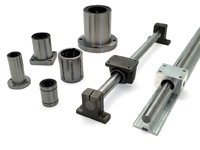
Posted to News on 14th Sep 2018, 00:00
A quick guide to selecting the best linear motion product
There is a vast range of linear motion products on the market and it can be difficult to know which product to select. Kate Harden of Euro-Bearings discusses the various types of products available and explores their advantages, disadvantages and limitations.

The primary purpose of linear motion products is to move something from one place to another in one direction along a straight line. Usually this is achieved using a bearing with a rolling element. Traditionally this rolling element would be a ball or roller, but these days some linear motion bearings do not incorporate a rolling element and consequently are known as ‘plain’ bearings. These plain bearings are simply plastic or ceramic bushes and are sometimes lined with PTFE or oil impregnated plastic to help reduce the sliding friction.
It is possible to achieve linear motion without bearings but moving a load without a bearing requires a lot more effort. Using a bearing significantly reduces the friction. For example the coefficient of friction for a recirculating ball bushing can be as low as 0.001 whereas steel against steel (with lubrication) has a coefficient of friction of 0.10.
Linear bearings can be moved in various ways. They can be driven by screws, belts, chains, rack and pinions, or simply pushed by hand. Linear motion products can be combined together to make multi-directional systems with 2 or 3 axes. Examples are an XY table (2 axes) or a CNC machine (3 axes).
Linear Bearings with balls offer the lowest friction. The two main products are recirculating ball bushings and motion guidance systems. Recirculating ball bushings are the traditional linear bearing and are used with hardened and ground shafts. The balls have a very small point contact area which enables very low rolling friction. However the small contact area means that they exert a high force on the shaft and consequently it is essential that they are only used on hardened shafts.
Motion guidance systems (known as ball guides and linear guideways) also use recirculating balls but they run on a profiled rail. The ball groove in these rails is usually gothic arch shaped to maximise the load capacity. Again the rail has to be hardened to prevent the highly loaded balls from deforming it. These systems are typically more tolerant of moments than the traditional recirculating linear bearings.
Roller bearings have a higher basic load rating than equivalent sized ball bearings. However they are less tolerant of lateral forces. Roller bearings are predominantly used as track rollers but they can also be used in cross roller guides.
Track bearings are bearings that roll on their outer diameter along a corresponding track. Usually they contain rollers as their rolling element, but sometimes they may contain balls (usually when radial load capacity is required). Track bearings are very versatile and come in many styles. The simplest is a heavy duty full complement roller bearing whilst others have profiled outer rings
(v-shaped or concave) to correspond with a shaped, and sometimes hardened, rail. They can be attached using spigots, threaded studs or weldable hubs. Other designs incorporate a secondary axial roller to accommodate lateral loads.
Roller guides are similar to ball guides but offer a greater load capacity when compared to the equivalent size ball version. Due to their compactness and precision they are often used in medical applications.
Cross roller slides offer very high accuracy and high load capacities. However the nature of their design leaves them vulnerable to contamination and consequently they are predominantly used in clean room or vacuum applications.
Plain bearings (or bushes) have evolved rapidly over the last 20 years with the development of low friction plastics. Plain bearings are typically made from plastic or ceramic. Whilst they offer reduced friction, usually the coefficient of friction is considerably higher than rolling element bearings.
Plastic linear bearings are cheap and do offer reduced friction compared to running two similar materials together. Being free of rolling elements there is less worry about product contamination from dirt, dust and debris and there is little noise. Today a wide range of plastics are available offering different advantages.
Ceramic linear bearings offer similar attributes to plastic linear bearings. They are quiet and smooth, typically available in the same sizes as traditional recirculating linear bearings and can be lubrication free. Furthermore some allow rotational motion to be combined with linear motion.
When selecting linear motion products there are many factors to consider. The range of products available is vast and each product comes in many shapes and sizes. Obviously price is always a factor, but each system has its own advantages and disadvantages and these should be taken into account when designing. Factors to consider include:
- Load capacity (are any moments involved?)
- Precision (micron precision of miniature ball guide rails to less precise track rollers)
- Support arrangement (fully supported, end supported, cantilevered or telescopic)
- Environment (dirty/dusty, clean room, vacuum, outside…)
- Corrosion resistance (medical, pharmaceutical, food industries)
- Size and scale (compact, heavy duty, or something in between)
- Friction (with regards to the drive system)
When specifying linear motion products, it is important to consider all the pros and cons of each product. Special attention should be paid to the friction as the coefficient of sliding friction (plain bushes) is markedly higher than that of rolling friction (balls and rollers). And clearly the force required to drive a system will be considerably higher for plain bushes (and in particular plastic bushes). But that said, they can still serve a purpose in lightweight applications.
For high accuracy applications recirculating ball bushings and ball guides are still the industry leaders. Ball bushings are versatile as they can be used fully supported (open type) or end supported (closed type). Linear ball and roller guides must be fully supported from either above or below. Whilst the roller linear guides offer higher load capacities, recent product development of the ball guides has narrowed the gap between their load capacities. Ball guides continue to be more popular than roller linear guides and consequently the prices tend to be lower.
Where dirt is an issue, the track bearings are clearly the best solution. They offer low coefficients of friction and there are different systems to suit a wide range of loads (for example cam followers, V-shaped bearings, combined roller bearings). The miniature market tends to be fulfilled by recirculating ball bushings and ball guides. Due to their extremely precise nature they are expensive and should only be specified when absolutely necessary.
The correct selection of linear motion products is essential for design longevity. It is important to consider all of the above aspects before choosing the type of rolling element (ball, roller or plain) and then specifying the final product. Whilst cost will always have a major influence, product suitability is key.
Units 29-31 Orchard House, Lodge Farm Business Centre
Wolverton Road, Castlethorpe
MK19 7ES
UNITED KINGDOM
+44 (0)1908 511733








